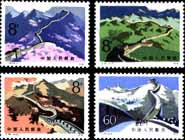The Great Wall

|
The Great Wall |
 |
Running some 6,700 kilometers on mountains and hills, the Great Wall lies to the southern edge of the Inner Mongolian plateau. It starts from Shanhaiguan Pass in the east and ends at Jiayuguan Pass in the west, winding across Hebei, Tianjin, Beijing, Shanxi, Inner Mongolia, Shaanxi, Ningxia and Gansu. As a wonder of the world, it was first built during the Spring and the Autumn period and the Warring States Period around 470 B.C., at a time when dukes and princes were contending for hegemony. In order to hold the enemy troops in check and prevent their invasions, walls were built at inaccessible places of strategic importance. With the rule of the Qin Dynasty over the unified China, the "ten thousand li" Great Wall was constructed connecting the original walls to prevent the Xiongnu invasions from north. The Qin's Great Wall stretched from Lintao (current Min County, Gansu) in the west to Jieshi of Liaodong (current south of Pyongyang of Korea) in the east. According to the book entitled "The Historic Record," 300 thousand people were drafted for the construction. "The Woman Mengjiang Weeping at the Great Wall" is a popular tale for generations about a woman searching high and low along the Great Wall for her husband who had toiled and perished. Her weeping was so tragic that the Wall collapsed in response. During the rule of the Ming Dynasty, the Mongolian and Nuzhen were rising. The Ming Dynasty invested a large amount of silver to repair the Great Wall with the hope of strengthening the defense against their invasions. Beacon towers were built to transmit military information. Ironically, the military significance of the Great Wall had hardly ever been presented. The Great Wall is a wonder in the world civilization as well as the spiritual symbol of the unsurpassed endurance of the Chinese people.
Design: This set of stamps depicted the Great Wall in four seasons. In spring, it is immersed in pink peach blossoms. In summer, green trees and grass grow luxuriously. In autumn, the view of mountains are in color of pretty yellow and red. In winter, the Great Wall is clothed in silvery white. Though the pictures are independent of each other, they make an organic whole when put together.
Chinese Topic
|
|
|
|
|
|
|
|
|
|
|
|
|
|
|